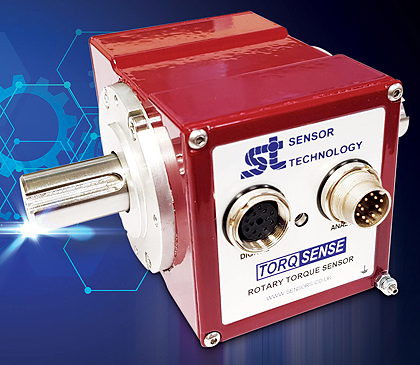- Home » News » Product News
Wireless torque sensors promise ±0.1% accuracies

The UK sensor manufacturer Sensor Technology has announced a new generation of non-contact torque sensors based on four-element strain gauge bridges that complement its existing non-contact sensors which use surface acoustic wave (SAW) detection, but offer improved accuracy for the same price.
The new TorqSense SGR510/520 devices have an over-range reading capability up to 250% of the rated torque, allowing them to measure and record sudden torque spikes accurately. They also compensate for forces such as bending moments applied to the sensor, and are more sensitive and have a wider temperature range than SAW devices.
The bridge consists of four strain gauges that are glued onto the monitored shaft in a square shape at 45 degrees to the axis of rotation. When torque is applied to the shaft, two gauges are stretched into tension and two go into compression. A miniature rotor-mounted controller, powered by an inductive coil, measures the differential values in each strain gauge and transmits them digitally to the stator, via the same coil. The transducers are said to offer high-bandwidth, low-cost torque measuring with good over-range and overload capabilities.
According to Sensor Technology sales engineer, Mark Ingham, they have several significant advantages over conventional torque sensors. For example, their design “eliminates the sort of noise pickup and signal corruption associated with slip-ring and other analogue methods of transferring torque data from rotor to stator.”
External noise pickup by the wiring is almost eliminated by the short distance between the strain gauge elements and the rotor’s measuring circuits. In addition, multipoint calibration reduces any linearity errors in the sensor.
The non-contact signal transfer means that the sensors do not need slip-rings. “Most torque sensors require slip-rings to transfer torque readings from the rotating shaft to the static readout,” Ingham explains. “These are noisy in use, slow and fiddly to set up and, as wearing parts, are not always reliable.”
The sensors’ large overrange capability allows torque signal peaks to be captured without any clipping when operating close to their full-scale ratings. This, combined with a mechanical overload capability of more than 400%, results in a robust torque-measuring system.
The measuring range is 1–500Nm (with models up to 13kNm in the pipeline), accuracy is ±0.1%, and resolution is ±0.01% of full scale. The digital transmission between rotor and stator cuts out cyclic fluctuation of the signal due to shaft rotation and allows digital sampling rates of 4,000 samples/s.
Analogue output voltages are configurable, and there is a choice of RS-232, USB, CANbus or external Ethernet gateway, as well as support for LabView virtual instruments. The sensors have built-in test functions.
Sensor Technology will continue to supply and support its existing SAW sensors but Ingham expects that, over time, most users will switch to the new technology. “The new SGR range is designed to meet almost all technical needs, so we expect it to become a popular first choice.”

Accuracies of ±0.1% are possible with the strain-gauge sensors, compared to ±0.25%, at best from the SAW sensors. Ingham expects this improvement for the same price to result in increased sales. The market for torque sensors is also growing, he adds.
Sensor Technology: Twitter LinkedIn





